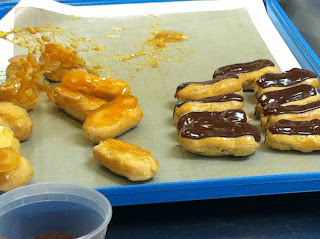For Lesson 18, we learned how to make doughs and tarts. We learned to make a savory dough (pate brisee) and a sweet dough (pate sucre). The pate brisee can be made with or without egg. We used the savory dough to make an onion tart (pate brisee without egg) and a quiche (pate brisee with egg). We used the sweet dough to make an apple tart and a pear tart.
The onion tart is made with onions, butter, vegetable oil, and bacon. The custard filling is made with an egg, and egg yolk, milk, cream, salt, pepper, nutmeg, and egg wash. The pate brisee without egg is made with flour, salt, sugar, butter, and water.
The onion tart was surprisingly good. This is me with our onion tart (Amy and I worked as a team):
A closer look at the onion tart:
2nd, we made the quiche. The quiche is made with vegetable oil, bacon, and gruyere cheese. The custard filling is made with milk, heavy cream, egg, egg yolk, salt, cayenne, nutmeg, and egg wash. The pate brisee with egg is made with flour, salt, sugar, butter, and egg.
Here is Amy with our quiche:
The quiche was FANTASTIC!
The onion tart (left) and the quiche (right):
Next, we moved on to sweet doughs. First we made an apple tart. The apple tart filling is made with apples, lemon, water, and sugar (made into an apple sauce type of consistency). The topping is made with apples, lemon, and butter. The finish is made with apricot glaze and water. And the pate sucre (sweet dough) is made with powdered sugar, butter, eggs, salt, flour, and baking powder.
This is our apple tart before baking:
Chef Bruno spun a sugar flower to put on his apple tart. This is his finished result:
This is the apple tart that Amy and I made:
Our final project was a pear tart. The pear tart is made with almond cream, pastry cream, and the pate sucre. Almond cream is made with almond paste, sugar, butter, eggs, almond extract, almond flour, and regular flour. The pastry cream is made with milk, a vanilla bean, egg yolks, sugar, flour, and cornstarch. The pastry cream and the almond cream are mixed together to make the filling and then the filling is topped with pear slices and brushed with apricot glaze. The pate sucre ingredients are listed above the apple tart picture.
This is our pear tart (very good if you like almond flavor):






















































